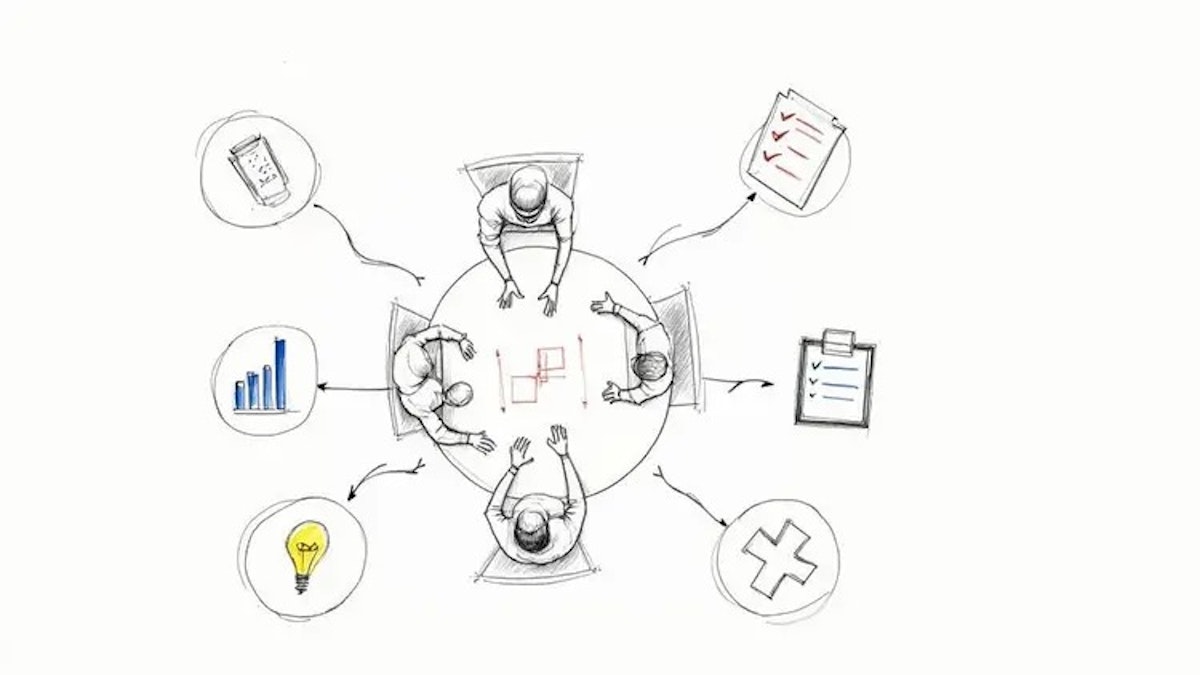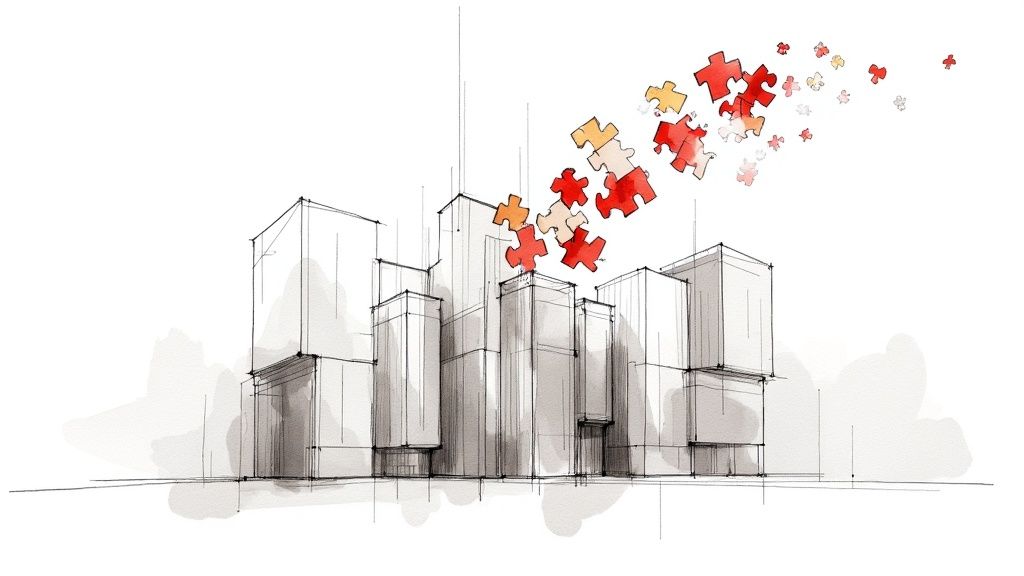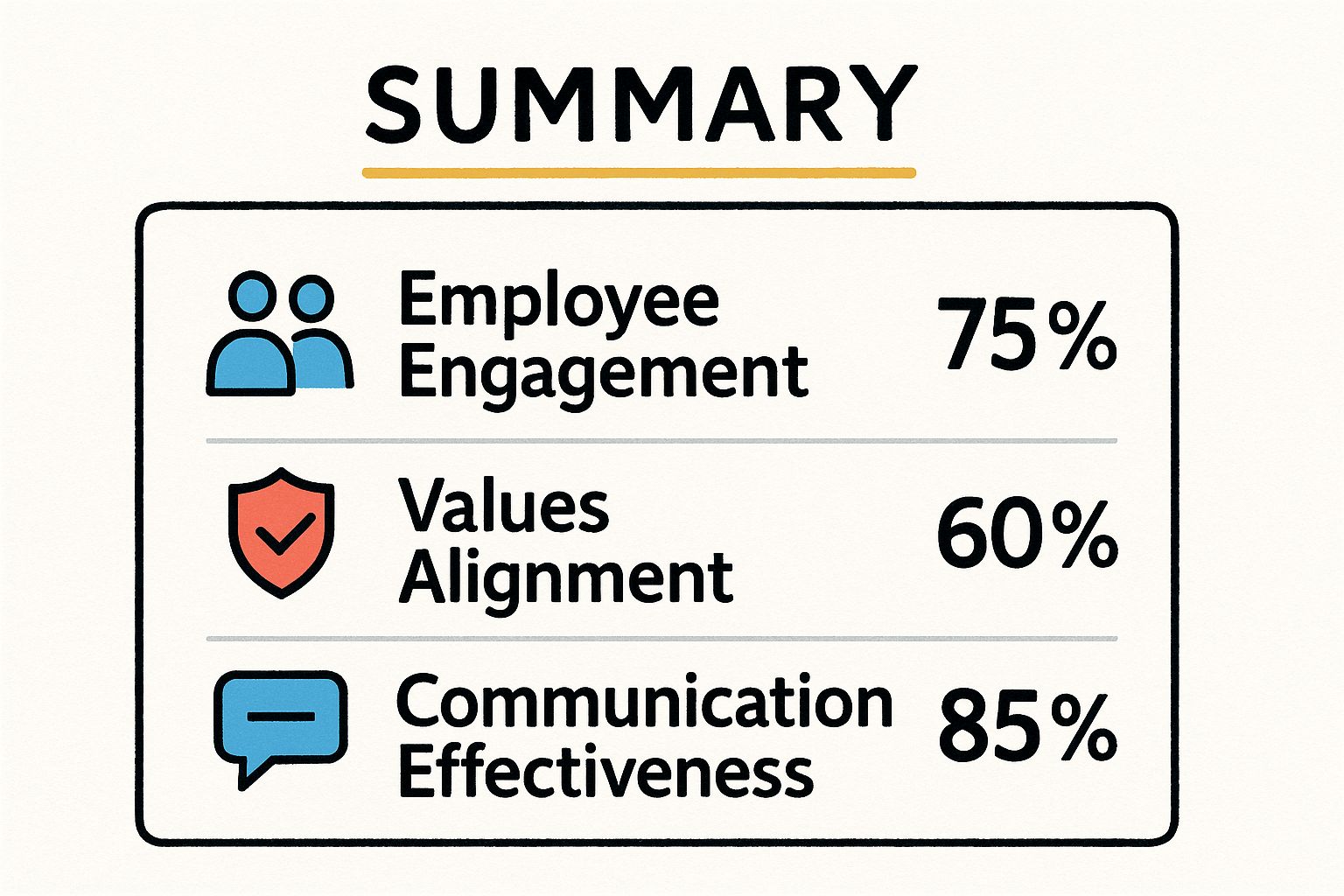Quick Guide to Organizational Culture Assessment

An organizational culture assessment is more than just a survey; it’s a deep dive into the heart of your company. Think of it as a diagnostic tool that reveals the shared values, beliefs, and unwritten rules that dictate how your team actually operates day-to-day. This process helps you see if the culture you think you have matches the reality your employees experience. It’s essential for spotting strengths to build on and uncovering dysfunctions before they start to drag down performance.
Why a Culture Assessment is a Strategic Must-Have

It’s easy to file culture assessments under "routine HR tasks," but that's a huge missed opportunity. In reality, it’s one of the most powerful strategic tools you have. Having a genuine understanding of your company’s unspoken norms and behaviors isn't a nice-to-have anymore—it’s non-negotiable for lasting success.
This isn't about abstract concepts. It’s about holding up a mirror to your organization's true identity. The insights you gain are the bedrock for attracting the right people, keeping them on board, and boosting your bottom line. It helps you answer the tough questions:
- Does our daily reality line up with our mission statement?
- Are our leaders walking the talk?
- Do our people feel safe enough to take risks and speak up?
The Modern Workforce Votes With Their Feet
Today's talent, especially the younger generations joining the workforce, see the employer-employee relationship differently. A paycheck is expected, but a supportive and engaging culture is what often seals the deal. This shift alone makes understanding your own culture more critical than ever.
The evidence is compelling. A Glassdoor survey found that 77% of adults would consider a company's culture before applying for a job there, and a staggering 92% of millennials believe company culture is important to their job satisfaction (APQC, 2021). With millions of new startups launching every year, a strong culture is no longer a soft perk; it's a core competitive advantage.
A toxic culture, riddled with poor communication and high turnover, is a direct threat to your growth. In contrast, companies that intentionally build environments based on trust, transparency, and respect don't just survive—they consistently outperform the competition. Research by Gallup consistently shows that business units in the top quartile of employee engagement are 23% more profitable than those in the bottom quartile.
Turning Insight Into Real Action
The goal of an assessment isn't just to collect interesting data points. It’s to build a practical roadmap for change. It gives you the hard evidence you need to get leadership buy-in and unite everyone around a common vision for improvement.
Instead of guessing what’s wrong, you get a clear diagnosis. For HR teams, this is the key to shifting from reactive firefighting to proactive, strategic culture-shaping. The rest of this guide will walk you through how to run a meaningful organizational culture assessment that gives you clear, actionable results. If you want a full A-to-Z overview, check out our complete organizational culture assessment guide for modern companies.
Choosing a Framework That Fits Your Organization
Trying to measure company culture without a good framework is like trying to bake a cake without a recipe. You might throw some ingredients together and get something, but it won't be what you were hoping for, and you'll have no idea how to replicate it or fix it. That's why latching onto an established model isn't just a good idea—it’s the essential first step.
A solid framework gives everyone a shared vocabulary. It takes the often fuzzy, gut-feel aspects of culture and puts them into a structure you can actually work with. This moves you from relying on subjective anecdotes to using objective data to drive real, targeted change.
The Power of the Competing Values Framework
Of all the models out there, one of the most practical and respected is the Organizational Culture Assessment Instrument (OCAI). Developed by professors Robert Quinn and Kim Cameron at the University of Michigan, it’s built on the Competing Values Framework, a powerful tool that boils down the complexities of culture into four main archetypes.
This isn't about getting a PhD in sociology; it's about getting a clear picture of where you are now and where you need to go. The framework helps you diagnose your dominant cultural traits across four types: Clan, Adhocracy, Market, and Hierarchy. Each one represents a fundamentally different way of operating, giving you a lens to see what your company truly values in practice, not just what's written on a poster.
A Quick Heads-Up: The point isn't to neatly fit your company into one of these four boxes. Real organizations are almost always a blend. The magic of the framework is in revealing which traits are currently running the show and which ones you might need to dial up or down to hit your strategic goals.
Understanding the Four Core Culture Types
To make this tangible, let's look at what these archetypes actually feel like on the ground.
- Clan Culture (The "Collaborate" Crew): Think of a tight-knit team where people genuinely have each other's backs. It feels more like a family than a workplace. The energy is all about mentorship, consensus, and shared commitment. Success here is measured by how well people are growing and how loyal they feel.
- Adhocracy Culture (The "Create" Innovators): Picture a fast-paced tech startup that's always chasing the next big thing. The vibe is dynamic, entrepreneurial, and a bit chaotic. People are encouraged to take risks and break the rules. Winning means launching groundbreaking products that leave competitors in the dust.
- Market Culture (The "Compete" Achievers): Imagine a highly driven sales organization where the scoreboard is everything. The focus is relentlessly external—on winning market share, crushing targets, and outperforming the competition. Success is defined by cold, hard numbers like revenue and profit margins.
- Hierarchy Culture (The "Control" Experts): Think of a large bank or government agency. The environment is all about structure, process, and stability. There are clear rules and procedures for everything to ensure predictability and minimize risk. Success means smooth, efficient, and error-free operations.
To get a better handle on these cultural dynamics, here’s a table that breaks down the OCAI model. It’s a great way to see how the different values and leadership styles stack up against each other.
The Four Types of Organizational Culture (OCAI Model)
| Culture Type | Core Focus | What Drives It | Leadership Style |
|---|---|---|---|
| Clan | People & Collaboration | Loyalty, teamwork, morale, development | Mentoring, facilitating, nurturing |
| Adhocracy | Innovation & Agility | Creativity, risk-taking, cutting-edge ideas | Entrepreneurial, visionary, risk-oriented |
| Market | Results & Competition | Market share, goal achievement, profitability | Hard-driving, competitive, results-focused |
| Hierarchy | Structure & Control | Efficiency, reliability, formal rules, stability | Coordinating, organizing, process-oriented |
Seeing these side-by-side makes it easier to spot the tensions and trade-offs. A company strong in Hierarchy might struggle with Adhocracy, and one focused on the Market might have a weak Clan culture. None is inherently "better"—it's all about strategic alignment.
Once you have a sense of your culture, translating those principles into daily operations is key. Things like an employee handbook for a culture-driven team can help make your cultural DNA explicit.
This visual gives you a snapshot of what assessment results can look like, highlighting a company's cultural health at a glance.

Right away, data like this tells a story. Here, it seems communication is flowing well, but there's a disconnect when it comes to the company's core values. A significant number of employees might not feel that deep connection to the mission.
Choosing Your Aspirational Culture
Knowing your current culture is just the starting point. The real strategic magic happens when you ask: What kind of culture do we need to build to win in the future?
A powerful assessment doesn't just measure the "now"; it also asks employees to describe their "preferred" future state. The gap between those two data points is where you'll find your roadmap for change.
Let’s say you discover your company is heavily reliant on Hierarchy and control, but your market is shifting, and you need to become more agile. That gap analysis gives you a clear mandate. Instead of a fuzzy goal like "we need to be more innovative," you get a concrete, data-backed objective. You can say, "Our goal is to shift our cultural profile 15% toward Adhocracy by empowering teams, funding experimental projects, and celebrating smart failures."
That’s a plan you can sell to leadership and rally your team around. It’s specific, measurable, and tied directly to a proven model for success.
Bringing Your Culture Survey to Life

Okay, you’ve picked your framework. Now it's time to roll up our sleeves and get practical. This is where we turn that theory into a real tool—one that can actually capture the voice of your people. A truly successful organizational culture assessment all comes down to a survey that's thoughtfully designed and carefully launched.
The quality of your questions will make or break this entire effort. The real goal here is to build a balanced survey that gives you both hard data and human stories. To do that, you need a smart mix of quantitative and qualitative questions.
The Power of Blending Question Types
Think of quantitative questions as the skeleton of your analysis. These are your measurable data points, usually using a Likert scale where employees rate statements from "Strongly Disagree" to "Strongly Agree." They’re essential for spotting trends and tracking progress over time.
But numbers alone don't tell the whole story. That's where qualitative questions come in. These open-ended prompts are your window into the "why" behind the data. They invite people to share their honest experiences, frustrations, and brilliant ideas in their own words. Without this context, you’re just guessing.
I’ve seen it happen time and again: a team gets bogged down in the numbers and misses the real gold hidden in the written comments. The most powerful, actionable insights almost always come from those candid, open-ended responses. They reveal the nuances you can't see in a spreadsheet.
For a good sense of how these questions can work together, it's worth looking at how a well-structured employee morale survey gathers feedback. The principles are very similar to a broader culture assessment.
Sample Questions for Key Culture Areas
Every single question you ask needs a purpose. Don't just throw things in; make sure each one ties directly back to the cultural dimensions you've decided to measure.
Here are a few examples to get you started:
Leadership Effectiveness:
- (Quantitative) "I have confidence in the leadership of this organization."
- (Qualitative) "What is one thing our leadership team could start doing to improve company culture?"
Communication Clarity:
- (Quantitative) "I feel well-informed about important decisions that affect my work."
- (Qualitative) "If you could change one thing about how we communicate as a company, what would it be?"
Strategic Alignment:
- (Quantitative) "I understand how my work contributes to the company's strategic goals."
- (Qualitative) "What is the biggest obstacle that gets in the way of you doing your best work?"
Want more inspiration? Our complete culture survey guide has a ton more examples and best practices for crafting questions that get you the answers you need.
Nailing the Launch Logistics
How you launch your survey is just as critical as what's in it. A sloppy rollout can kill trust and tank your participation rates before you even start. You need to focus on three things: anonymity, communication, and timing.
Guaranteeing Anonymity
This is non-negotiable. Your people will only give honest feedback if they feel completely safe. Always use a third-party platform that guarantees confidential, aggregated responses.
Shout this from the rooftops in your communications. Make it crystal clear that raw, individual data will never be seen by managers or leadership—only summarized themes.
Communicating the "Why"
Don't just drop a survey link in an email. Everyone is tired of taking surveys that disappear into a black hole. Before the launch, create a solid communication plan that clearly explains:
- Why you're doing this assessment now.
- What you hope to learn.
- How the results will be used to make real changes.
- When they can expect to hear about the findings and next steps.
This level of transparency is the single biggest factor in getting people to participate. When your team believes their voice matters, they’ll invest the time to give you thoughtful feedback.
Choosing the Right Moment
There’s no "perfect" time, but there are definitely bad ones. Avoid launching during a major re-org, the busiest sales quarter, or right before a long holiday weekend.
The best companies make this a regular event. According to Ethisphere's analysis of the World's Most Ethical Companies, 96% of these top-performing organizations conduct a culture survey at least every two years. This creates a predictable rhythm and shows everyone that cultural health is a core part of how the business operates.
From Raw Data to Actionable Cultural Insights
Collecting survey responses is just the starting whistle; the real game is won in the analysis. That raw data from your organizational culture assessment—a mix of quantitative scores and open-ended comments—is really just noise until you shape it into a clear, compelling narrative about your company's true character. This is the moment you shift from simply measuring to genuinely understanding.
Your first move is to create that high-level, bird's-eye view of your quantitative results. Aggregate the scores to map out your current cultural profile. When you compare these findings to the ideal culture you identified when choosing your framework, you’ll immediately spot the biggest gaps between where you are and where you want to be.
Uncovering Themes in Qualitative Feedback
While numbers tell you what is happening, the written comments give you the invaluable why. This is where you put on your detective hat and apply thematic analysis to sift through all that qualitative feedback. Don't just scan for keywords; you need to actually read through the responses to feel out the recurring ideas, sentiments, and pain points.
Start grouping similar comments into broader themes. For example, you might notice clusters of feedback popping up around:
- Leadership visibility: "I wish we heard from our leaders more often."
- Cross-departmental friction: "The sales and product teams seem to be working against each other."
- Recognition gaps: "Good work rarely gets acknowledged here."
This process is how you turn hundreds of individual voices into a handful of powerful, actionable themes. These are the human stories behind the data points, and they’re what reveal hidden strengths, employee frustrations, and the real root causes of disengagement.
The most profound discoveries in a culture assessment often come from the qualitative data. I've seen a single, well-articulated employee comment illuminate a systemic issue far more effectively than a dozen charts ever could.
The Critical Role of Data Segmentation
Looking only at company-wide averages can be dangerously misleading. A great overall score might be masking a toxic subculture brewing in a specific department or a deep sense of disconnect among your most tenured employees. This is why segmenting your data isn't just a best practice—it's absolutely essential for an accurate diagnosis.
Break down your results by meaningful employee groups. Some of the most common and insightful segments include:
- Department or function (e.g., Engineering vs. Marketing)
- Tenure (e.g., employees with 0-2 years vs. 10+ years of service)
- Role level (e.g., individual contributors vs. senior managers)
- Location (e.g., headquarters vs. regional offices)
By comparing how these different segments answered, you can pinpoint exactly where cultural issues are coming from. For instance, you might find that while new hires are optimistic, employees with over five years of service are deeply cynical. That insight helps you diagnose the root cause—perhaps a lack of growth opportunities—instead of just treating the symptom of low morale.
For a deeper dive into this part of the process, you can explore our detailed guide on understanding culture assessment results with data-driven insights.
Connecting Culture to Business Outcomes
A truly powerful culture assessment moves beyond just measuring feelings; it links the health of your culture to tangible business results. The connection between culture and engagement is particularly strong. We all know culture is important, yet global employee engagement remains a stubborn challenge. According to Gallup's 2023 "State of the Global Workplace" report, only 23% of employees worldwide are actively engaged at work. This often signals a major gap between the company values on the wall and the actual employee experience.
Effective assessments diagnose these gaps by analyzing key dimensions such as leadership, strategic emphasis, and what holds the organization together, as defined in models like Cameron and Quinn's. When you start to correlate your assessment data with hard metrics like productivity, innovation rates, or technology adoption, you build an undeniable business case for change.
This is what transforms your conversation with leadership. Instead of saying, "Our employees feel our culture is too hierarchical," you can say, "Our strong hierarchical culture is correlated with a 15% lower innovation score in our product teams, which directly impacts our ability to compete." An evidence-based argument like that is what secures resources and drives real, meaningful action.
Building Your Culture Action Plan

Let's be frank. An organizational culture assessment without a clear action plan is just an interesting data-gathering exercise. It’s a map without a destination. This final step is where the rubber meets the road—where you turn all those hard-won insights into a tangible strategy for real, meaningful change.
The data is only the starting point. Your real mission now is to use that data to build momentum, get the resources you need, and drive improvements that actually stick.
Presenting Results to Secure Leadership Buy-In
Your first, and arguably most important, audience is your leadership team. How you present your findings will determine whether your initiative gets the green light or gets quietly forgotten.
This is not the time for a dry data dump. Your job is to tell a story.
Frame the assessment results as a critical business case. You need to connect the dots between the cultural data—like low scores on innovation or poor cross-departmental communication—and the company's strategic goals. Don't just say, "Our collaboration scores are down." Instead, try something like, "Our analysis shows that friction between teams is delaying our product launch timelines by an average of 15%." See the difference?
Use strong visuals to highlight the most critical gaps between where your culture is today and where you want it to be. Focus on just 2-3 key themes that will have the biggest impact. When you present a clear, evidence-based narrative that links cultural health directly to performance, you'll get the buy-in and resources you need.
After you've analyzed the insights, the next step is to figure out how to improve team culture in a way that truly works.
Prioritizing Initiatives for Early Momentum
You can't fix everything at once. I’ve seen teams try, and it’s a surefire recipe for burnout and failure. The secret is to prioritize strategically to build momentum. A simple impact/effort matrix is one of my go-to tools for this.
It’s simple. Just categorize your potential initiatives into four quadrants:
- High-Impact, Low-Effort (Quick Wins): Start here. These are your top priorities because they deliver visible results fast, which builds confidence in the whole process. Think about launching a new peer-to-peer recognition channel on Slack.
- High-Impact, High-Effort (Major Projects): These are your big, strategic moves, like overhauling your performance management system or rolling out a new leadership development program.
- Low-Impact, Low-Effort (Fill-Ins): Tackle these when you have a spare moment, but don't let them distract you from the bigger fish.
- Low-Impact, High-Effort (Time Wasters): Avoid these like the plague. They just drain resources with little to show for it.
By focusing on those "Quick Wins" first, you create a powerful ripple effect. When employees see that their feedback is leading to immediate, positive changes, it builds trust and makes them more willing to engage in the harder, long-term work.
Assembling Cross-Functional Culture Champions
Culture change can't be an HR-only project. For it to work, it has to be a shared responsibility woven into the fabric of the entire company.
One of the best ways I’ve seen this done is by creating a cross-functional 'culture committee' or a team of champions.
This group needs to be a true cross-section of your organization—pull in influential people from different departments, levels, and even office locations. Their job isn't to do all the work. It’s to champion the initiatives within their own teams, act as a listening post for feedback, and keep the conversation about culture alive and well.
This approach makes the action plan feel relevant and practical for everyone, not just another top-down mandate. It transforms "culture" from an abstract idea into something tangible that everyone has a stake in building. You can dig deeper into this by checking out our guide on how a core values assessment helps measure and improve value alignment.
Committing to a Continuous Cycle of Improvement
Finally, it’s critical to remember that culture work is never really "done." An assessment isn't a one-time fix; it's a snapshot in an ongoing cycle of improvement. The best companies I've worked with treat their cultural health as a core business metric, right alongside revenue and customer satisfaction.
So, how do you do that? Embed this process into your company's natural rhythm.
Schedule a comprehensive organizational culture assessment every 18-24 months. In fact, data from Ethisphere shows that 96% of the World's Most Ethical Companies conduct a culture survey at least every two years.
But don't stop there. Supplement those big assessments with lightweight, quarterly "pulse" surveys. These shorter check-ins can focus on the specific areas you’re trying to improve, giving you a continuous feedback loop. This not only shows employees you’re committed for the long haul but also ensures your action plan stays relevant as your organization evolves.
Common Questions About Culture Assessments
Even with the best game plan, running a culture assessment for the first time is bound to stir up some questions. Getting ahead of these concerns is smart—it not only gives your HR team confidence but also builds a foundation of trust with employees. Let's walk through some of the most common hurdles you'll likely encounter and how to handle them.
How Can We Guarantee Employee Anonymity for Honest Feedback?
This is the big one. If your team suspects their answers aren't truly private, you can forget about getting honest feedback. It just won't happen. The best way to lock down privacy is by using a trusted third-party survey tool designed specifically for this. These platforms aggregate responses and are built so that individual data is never revealed.
You need to shout this from the rooftops. Make your commitment to anonymity a core part of your survey introduction and every email you send about it. When it comes to open-ended questions, reassure everyone that their comments will be grouped by theme and only presented as a summary—never as direct, attributable quotes. A pro tip: be careful with demographic questions. If a team is small, asking for too much specific detail could accidentally pinpoint an individual.
What Is the Biggest Mistake to Avoid?
The single most damaging mistake you can make is doing nothing with the results. Launching a huge culture assessment, collecting all that data, and then letting it fall into a black hole is worse than never having done the survey at all. It tells your employees their feedback was a waste of time, which breeds cynicism and tanks participation for any future initiatives.
When a survey disappears without a trace, it sends a clear message: "We heard you, but we don't care." This kills trust and makes it infinitely harder to get people on board next time.
To sidestep this disaster, map out your communication plan before you even send the survey link. This plan needs to be concrete, detailing when and how you’ll share the findings and what first steps you’ll take based on what you learn.
How Often Should We Conduct a Culture Assessment?
Finding the right rhythm is crucial. You want a continuous loop of feedback, but you don't want to burn everyone out with constant surveys. For a deep, comprehensive assessment, the sweet spot is generally every 18 to 24 months. This gives you enough time to actually implement changes and see if they're making a real difference.
This isn't just a guess; it's what leading organizations do. In fact, according to data from Ethisphere, a staggering 96% of the World's Most Ethical Companies run a culture survey at least every two years. It's how they stay on track and continuously strengthen their workplace. You can always supplement these big annual or biennial check-ins with shorter, quarterly "pulse" surveys that drill down on specific areas you’re actively working to improve.
What if the Assessment Uncovers a Toxic Culture?
First, take a deep breath. Uncovering a toxic culture isn't a failure—it’s a critical moment that gives you the chance to fix what's broken. Your immediate first step is to take the raw, unfiltered data straight to your leadership team. Don't frame it as a blame game. Instead, present it as a serious business risk that's hitting your retention, productivity, and even your brand.
From there, triage the most severe problems. Issues like toxic leadership behaviors or hints of harassment need to be at the top of your list. It's often a good idea to bring in an external, neutral facilitator to run some focus groups. This creates a psychologically safe space for employees to dig into the root causes without fear. Be transparent with your people. Acknowledge the problems head-on and commit publicly to a clear, long-term action plan for turning things around.
Ready to move beyond guesswork and build a stronger, more cohesive team? MyCulture.ai provides the science-backed tools you need to assess, understand, and improve your organizational culture. Generate custom assessments in minutes to measure value alignment, screen for culture fit, and guide data-driven decisions that boost retention and performance. Start building your dream team today.